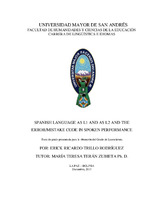SPANISH LANGUAGE AS L1 AND AS L2 AND THE ERROR/MISTAKE CODE IN SPOKEN PERFORMANCE

View/
Date
2013Author
Trillo Rodríguez, Erick Ricardo
Terán Zubieta, María Teresa (tutor)
Metadata
Show full item recordAbstract
This study is intended to contribute to the development of the current methods and materials, for teaching/learning Spanish as a second language in Bolivia, by offering a list of the most common errors that language learners make when performing Spanish as their L2. These lists have multiple pedagogical uses.
We have done a contrastive analysis of errors in spoken language performance based on the Innatist/Naturalistic approaches for FLA and SLL to prove or falsify the Chomsky’s statement (1968) “children learning their first language make errors similar to that of students of a second language”, if so the errors in oral language performance, in children and in L2 learners, should be the same or at least similar. By this, what we try to do is to open a discussion considering the effectiveness and appropriateness of the second language learning materials.
Moreover to suggest that, in a way to avoid that second language errors could lead to fossilization, the results of error’s analysis should be considered as a core element when designing and developing second language teaching/learning methods as well as materials.
The present work is structured into the following chapters: Problem Statement, Justification, Objectives, Theoretical Framework, Error Analysis Model and Contrastive Analysis Model, a subdivision in two parts: Part One. Second Language Learning, describing the naturalistic approaches and methods for SLL as well as Interlanguage and its stages, and Part Two. First Language Acquisition, describing the Innatist approach for FLA as well as the Critical Period and its stages and whole cognitive tools that allow an access to the mother tongue, Methodology, Data Collection and Data Interpretation. We here describe the instruments used, the samples, in greater detail, the analyses, and the Conclusions and Recommendations.
